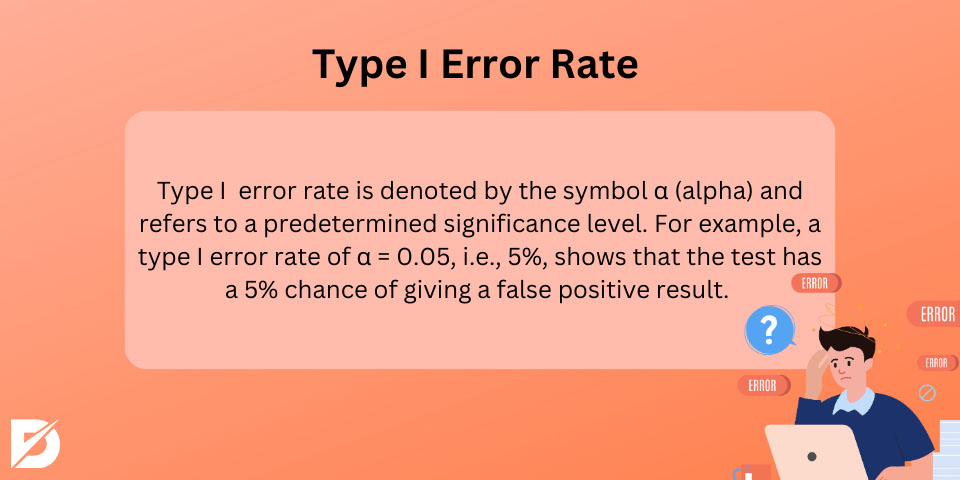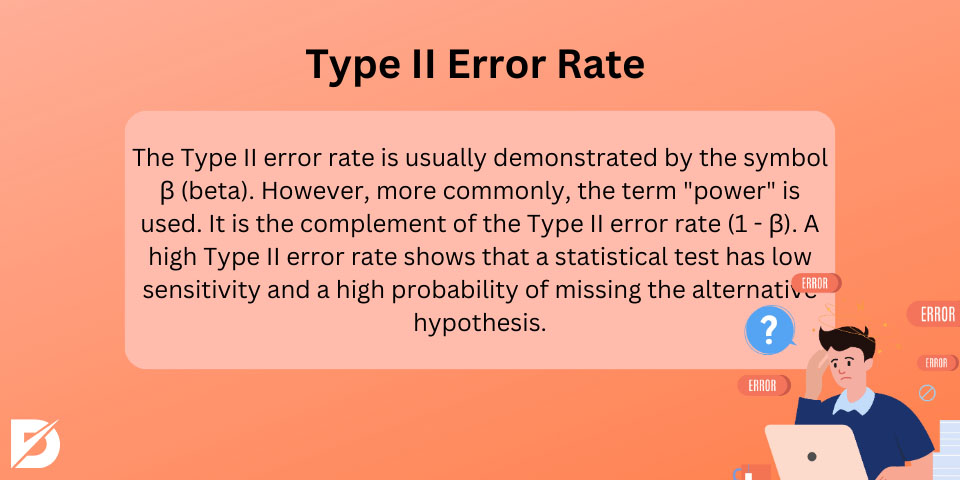In science, we can sometimes make erroneous conclusions when checking our theses. There are many reasons for these mistakes, such as things that escape one’s attention, faulty data, and more. Statistics is a really confusing branch and is essentially a game of probability. Because no matter how small the calculations are, there is always the possibility of being wrong. It happens for many different reasons.
We spend much time trying to make these errors happen less often. We can’t do it unless we know exactly what’s causing the outcome we’re studying, and that’s not always possible. So, while we aim to minimize these errors, we can’t make them disappear completely if we don’t understand everything about the situation we’re studying. A crucial concept helps researchers make informed decisions and draw meaningful conclusions. It’s called “Type I” and “Type II” errors. Understanding them is vital in fields like medical science, biometrics, computer science, and digital marketing.
Errors In A/B Testing
A/B testing is a way of determining the best-performing model among two or more versions of online assets. A/B tests, which have grown in popularity as digital competition has increased, are often produced for websites, online apps, and digital marketing initiatives.
They are analyzed to determine the version that will achieve the targeted conversion rate among different variants. You can never be completely certain of the correctness of your results or eliminate all danger. You can only improve the chance that the test result is correct. The only thing to do when implementing A/B testing is to direct different content and design models to different visitors. In fact, it is also appropriate to test different examples on the same users. However, it will be difficult to get a serious return when new visitor traffic is high. Type 1 and Type 2 errors ultimately result in wrong test results and/or improper declarations of winner and loser. As a result, test result reports are misinterpreted.
Type I Error (False Positives)
A Type I error, also known as a false positive, occurs when a null hypothesis that is actually true is incorrectly rejected based on the statistical evidence. In other words, it’s when a test or experiment falsely indicates the presence of an effect or difference that doesn’t actually exist. Type I errors are associated with a certain level of significance (alpha, denoted by α), and they represent the probability of making such an error in a hypothesis test. Imagine you’re in a courtroom, and an innocent person is wrongly convicted. This is similar to what happens in statistics when we make a “Type I Error,” where we mistakenly believe something is true when it’s actually not. For instance, in medical tests, it’s when the test suggests you have a disease, but you’re actually healthy. This kind of error can lead to unnecessary worry or actions.
Furthermore, a Type I error is a type of error in statistical hypothesis testing and is called a “false positive”. In other words, it is the error of mistakenly reaching a positive conclusion about a situation or hypothesis test result when something negative should have been thought about. That is, the test incorrectly indicates the presence of the disease. Type I errors are important in hypothesis testing because they can lead to incorrect conclusions in science and statistics. It is, therefore, important to control and minimize this type of error in statistical analysis.
Type I Error Rate
The type I error rate is the probability that a null hypothesis is incorrectly rejected during a statistical hypothesis test. Hence, the type I error rate refers to the probability of falsely rejecting something actually true. This rate measures the sensitivity of the statistical test or how often the test tends to give false positive results.

Usually, this rate is denoted by the symbol α (alpha) and refers to a predetermined significance level. For example, a type I error rate of α = 0.05, i.e., 5%, shows that the test has a 5% chance of giving a false positive result. In many statistical tests, a balance must be struck between the type I error rate and the type II error rate. Because of the inverse relationship between these two error rates, if the type I error rate is reduced, the type II error rate may increase and vice versa. In statistical analysis, it is often important to consider this balance when setting the α level because it depends on which type of error is more acceptable and the reliability of the results.
Type II Error (False Negatives)
Type II error is a type of error in statistical hypothesis testing and is called a “false negative”. The thing about this error is the error of reaching a conclusion that is actually correct. It is the error of mistakenly reaching a negative conclusion about a situation or hypothesis test result when something positive should have been thought about.
For example, let’s take a medical test again. If a patient is incorrectly determined by the test to not have a disease when they do have a disease, this is a Type II error. That is, the test incorrectly indicates the absence of the disease. Type II errors are also important in statistical analysis because they can lead to incorrect conclusions and affect important scientific and clinical results. It is, therefore, important to control and minimize these type I and type II errors in statistical hypothesis testing.
Type II error rate
This error is the error of reaching a false conclusion, and the Type II error rate refers to the probability that an “alternative hypothesis” is incorrectly rejected during a statistical hypothesis test.

The alternative hypothesis usually refers to a change or effect. Falsely rejecting this hypothesis in a test is a Type II error. The Type II error rate is usually demonstrated by the symbol β (beta). However, more commonly, the term “power” is used. It is the complement of the Type II error rate (1 – β). A high Type II error rate shows that a statistical test has low sensitivity and a high probability of missing the alternative hypothesis. A higher power increases the probability of correctly recognizing the alternative hypothesis.
Ambiguity in the definition of false positive rate
There are two terms, “false discovery rate” (FDR) and “false positive risk” (FPR), that help us understand the chances of making mistakes. Let’s make them easier to understand:
- False Discovery Rate (FDR): FDR tells us how likely it is that something we find as “important” is actually a mistake, like thinking a false alarm is real. Imagine you’re experimenting, and you find something that seems important. FDR helps us estimate how often we might be wrong about its importance. FDR is useful when dealing with many comparisons, like testing many things at once.
- False Positive Risk (FPR): FPR is just another way to talk about the same thing as FDR, but it’s used to avoid confusion when people work on many comparisons. Both FDR and FPR help us understand the risk of making a mistake by thinking something is true when it’s not.
Avoiding confusion, these two ideas have confused, like mixing up similar-sounding words.
How to Improve Hypothesis Testing Quality
Methods to make hypothesis tests more accurate and reliable by reducing the chances of making errors and improving their overall quality. Improving hypothesis testing qualities are listed below:

- Correct Results Rate: We can assess the quality of hypothesis tests by considering how often they provide accurate results.
- Reducing Type I Errors: To lower the chance of a Type I error (mistakenly concluding something is true when it’s not), we can make the alpha value stricter, which is a simple and effective method.
- Decreasing Type II Errors: To reduce the probability of a Type II error (missing something actually true), we can either increase the sample size or relax the alpha level. This enhances the test’s power to detect real effects.
- Robust Test Statistic: A test statistic is considered robust when it controls the Type I error rate.
- Adjusting Thresholds: By changing the threshold values, we can make a test more specific or more sensitive, thus improving its quality. For instance, in a medical test, adjusting the threshold can affect how diseases are diagnosed based on certain measurements.
How do we avoid type I errors?
Avoiding Type I errors in statistical hypothesis testing is vital for making accurate and reliable conclusions. To help minimize the risk of Type I errors are listed below:
- Set a Strict Significance Level (Alpha): Choose a lower significance level (alpha) for your hypothesis test. The most common choice is alpha = 0.05, which means you are willing to accept a 5% chance of making a Type I error.
- Use Bonferroni Correction: If you’re conducting multiple comparisons or tests, apply the Bonferroni correction. This method adjusts the alpha level to account for the increased risk of Type I errors.
- Increase Sample Size: A larger sample size can improve the power of your test, making it more likely to detect true effects.
- Careful Experimental Design: Make sure your experimental design is robust and well-controlled. Minimize sources of variability that can increase the chance of Type I errors.
- Replication and Validation: Replicate your findings or seek independent validation of your results. Consistent results from different studies provide stronger evidence against Type I errors.
- Understand Assumptions: Be aware of the assumptions underlying your statistical tests. Violating these assumptions can increase the risk of Type I errors.
- Use Bayesian Statistics: Consider using Bayesian statistics, which provide a different framework for hypothesis testing and can help control Type I error rates more effectively.
- Transparent Reporting: Report your methodology, statistical procedures, and results in a transparent and reproducible manner. This allows others to assess the validity of your findings.
How Do You Avoid Type II Errors?
Minimizing Type II errors often involves a trade-off with Type I errors, and the appropriate balance depends on your research’s specific goals and consequences. To help minimize the risk of Type II errors are listed below:
- Increase Sample Size: One of the most effective ways to reduce Type II errors is to increase your sample size. A larger sample provides more statistical power.
- Use a More Sensitive Test: Choose a statistical test or method known for its sensitivity. Some tests are better at detecting small effects than others.
- Adjust the Significance Level: You can make your test more lenient by relaxing the alpha (significance) level. While this increases the risk of Type I errors, it reduces the risk of Type II errors.
- Understand Effect Size: Pay attention to the effect size, which measures the practical significance of a result. Also, a larger effect size is easier to detect.
- Replication and Meta-Analysis: Replicate your study or combine your results with other similar studies through meta-analysis.
- Prior Information: Consider prior knowledge or information about the phenomenon you’re studying. If there’s strong prior evidence of an effect, you may need a smaller sample size to detect it.
- Use Bayesian Statistics: Bayesian statistics can provide an alternative approach to hypothesis testing and may be more appropriate for certain research questions.
- Conduct a Power Analysis: Before conducting your study, perform a power analysis to estimate the required sample size for a given effect size and significance level.
- Be Mindful of Assumptions: Ensure that your data meet the assumptions of your statistical tests.
- Consider Follow-Up Studies: If your initial study doesn’t yield vital results, consider conducting follow-up studies with larger samples or modified methodologies to increase your chances of detecting the effect.
Which type I or Type II error is worse?
This question often depends on whether you’re looking at it from a statistical or practical perspective. For statisticians, a Type I error is typically viewed as more significant. This error occurs when you incorrectly reject the null hypothesis, essentially going against the fundamental statistical assumption. The consequences can be substantial, leading to implementing new policies, practices, or treatments that are either ineffective or wasteful of valuable resources.
Type I and Type II Errors and A/B Testing
A/B testing involves analyzing data and making decisions based on it. It’s important to consider Type I and Type II errors in this context. Balancing these factors is crucial. Lowering the significance level reduces the risk of Type I errors but increases the risk of Type II errors. Increasing the sample size reduces both types of errors. Careful planning is necessary for A/B testing, including deciding significance levels, statistical power levels, and sample sizes. This minimizes costly errors and ensures reliable and actionable results. Setting significance and statistical power levels before conducting the test helps decrease these errors in A/B testing.
Frequently Asked Questions About
Controlling Type 1 and Type 2 errors in hypothesis testing involves various strategies and considerations, depending on your study’s specific goals and constraints.
Types of errors Type I errors (false positive): A null hypothesis is rejected by the researcher that is correct in the population. Type II errors (false negative): A null hypothesis not rejected in the population is false.
The sample size does not determine the probability of a Type I error (false positive) in hypothesis testing. The probability of a Type I error is primarily determined by the chosen significance level (alpha) and the specific statistical test being used.
When the likelihood of one error is reduced, the possibility of the other error increases. As a result, changing the conclusion of one test influences the outcome of the other.
The standard deviation does not directly affect the Type 1 error rate (false positive rate) in hypothesis testing. The standard deviation does, however, indirectly influence hypothesis testing.





No comments to show.